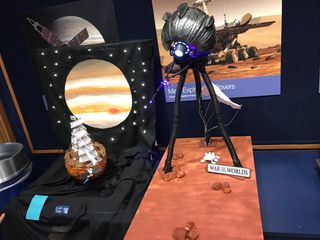Have a 'War of the Worlds' Radio Party This Halloween!

Eighty years ago this week, "War of the Worlds" aired across the country and secured a creepy legacy for Grover's Mill, New Jersey. For Halloween this year, why not take a listen yourself to the historic broadcast?
"War of the Worlds" aired as a part of Orson Welles' Mercury Theatre on the Air radio program on Oct. 30, 1938, and was based on H.G. Wells' science fiction novel first serialized in 1897. Because of its realistic tone — the story is told, at first, in a series of "breaking news" interruptions to a music program — many listeners at the time thought that a real Martian invasion was happening, and that New Jersey (and later New York) was falling. [The "War of the Worlds" Radio Broadcast Explained]
You can relive the terror for yourself with the full broadcast audio embedded below, courtesy of Archive.org. Or throw a listening party and pretend the civilization-destroying forces are coming from out of this world.
Email Sarah Lewin at slewin@space.com or follow her @SarahExplains. Follow us on Twitter @Spacedotcom and on Facebook. Original article on Space.com.
Get the Space.com Newsletter
Breaking space news, the latest updates on rocket launches, skywatching events and more!
Join our Space Forums to keep talking space on the latest missions, night sky and more! And if you have a news tip, correction or comment, let us know at: community@space.com.

Sarah Lewin started writing for Space.com in June of 2015 as a Staff Writer and became Associate Editor in 2019 . Her work has been featured by Scientific American, IEEE Spectrum, Quanta Magazine, Wired, The Scientist, Science Friday and WGBH's Inside NOVA. Sarah has an MA from NYU's Science, Health and Environmental Reporting Program and an AB in mathematics from Brown University. When not writing, reading or thinking about space, Sarah enjoys musical theatre and mathematical papercraft. She is currently Assistant News Editor at Scientific American. You can follow her on Twitter @SarahExplains.
